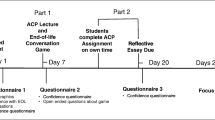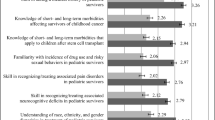Abstract
Discussing end-of-life decisions with cancer patients is a crucial skill for physicians. This article reports findings from a pilot study evaluating the effectiveness of a computer-based decision aid for teaching medical students about advance care planning. Second-year medical students at a single medical school were randomized to use a standard advance directive or a computer-based decision aid to help patients with advance care planning. Students' knowledge, skills, and satisfaction were measured by self-report; their performance was rated by patients. 121/133 (91%) of students participated. The Decision-Aid Group (n = 60) outperformed the Standard Group (n = 61) in terms of students´ knowledge (p < 0.01), confidence in helping patients with advance care planning (p < 0.01), knowledge of what matters to patients (p = 0.05), and satisfaction with their learning experience (p < 0.01). Likewise, patients in the Decision Aid Group were more satisfied with the advance care planning method (p < 0.01) and with several aspects of student performance. Use of a computer-based decision aid may be an effective way to teach medical students how to discuss advance care planning with cancer patients.

Similar content being viewed by others
References
Doukas DJ, Brody H (1992) After the Cruzan case: the primary care physician and the use of advance directives. J Am Board Fam Pract 5:201–205
Lo B, Steinbrook R (2004) Resuscitating advance directives. Arch Intern Med 164:1501–1506
Miles S, Koepp R, Weber E (1996) Advance end-of-life treatment planning. Arch Intern Med 156:1062–1068
Moskop JC (2004) Improving care at the end of life: how advance care planning can help. Palliat Support Care 2:191–197
Mullan PB, Weissman DE, Ambuel B, von Gunten C (2002) End-of-life care education in internal medicine residency programs: an interinstitutional study. J Palliat Med 5:487–496
Prendergast TJ (2001) Advance care planning: pitfalls, progress, promise. Crit Care Med 29:N34–N39
Schwartz CE, Merriman MP, Reed GW, Hammes BJ (2004) Measuring patient treatment preferences in end-of-life care research: applications for advance care planning interventions and response shift research. J Palliat Med 7:233–245
Tulsky JA (2005) Beyond advance directives: importance of communication skills at the end of life. JAMA 294:359–365
Emanuel LL, Emanuel EJ (1989) The Medical Directive. A new comprehensive advance care document. JAMA 261:3288–3293
McAuley WJ, Buchanan RJ, Travis SS, Wang S, Kim M (2006) Recent trends in advance directives at nursing home admission and one year after admission. Gerontologist 46:377–381
Quill TE (2005) Terri Schiavo–a tragedy compounded. N Engl J Med 352:1630–1633
Barnard D, Quill T, Hafferty FW, Arnold R, Plumb J, Bulger R, Field M (1999) Preparing the ground: contributions of the preclinical years to medical education for care near the end of life. Working Group on the Pre-clinical Years of the National Consensus Conference on Medical Education for Care Near the End of Life. Acad Med 74:499–505
Schonwetter RS, Robinson BE (1994) Educational objectives for medical training in the care of the terminally ill. Acad Med 69:688–690
Sullivan AM, Lakoma MD, Billings JA, Peters AS, Block SD, Faculty PC (2005) Teaching and learning end-of-life care: evaluation of a faculty development program in palliative care. Acad Med 80:657–668
Sullivan AM, Lakoma MD, Block SD (2003) The status of medical education in end-of-life care: a national report. J Gen Intern Med 18:685–695
Block SD (2002) Medical education in end-of-life care: the status of reform. J Palliat Med 5:243–248
Buss MK, Marx ES, Sulmasy DP (1998) The preparedness of students to discuss end-of-life issues with patients. Acad Med 73:418–422
Green MJ, Levi BH (2009) Development of an interactive computer program for advance care planning. Health Expect 12:60–69
Jain NL, Kahn MG (1995) Using knowledge maintenance for preference assessment. Proc Annu Symp Comput Appl Med Care 1995:263–269
Torrance GW, Boyle MH, Horwood SP (1982) Application of multi-attribute utility theory to measure social preferences for health states. Oper Res 30:1043–1069
Torrance GW, Feeny DH, Furlong WJ, Barr RD, Zhang Y, Wang Q (1996) Multiattribute utility function for a comprehensive health status classification system. Health Utilities Index Mark 2. Med Care 34:702–722
Torrance GW, Furlong W, Feeny D, Boyle M (1995) Multi-attribute preference functions. Health Utilities Index. Pharmacoeconomics 7:503–520
Farace E, Marupudi N, Green MJ, Levi BH, Sheehan JM (2008) The Society for NeuroOncology 13th Annual Scientific Meeting, Las Vegas, NV
Green MJ, Levi BH, Farace E (2007) Society for Medical Decision Making 29th Annual Meeting, Pittsburgh, PA
Green MJ, Levi BH, Farace E (2008) American Society of Preventive Oncology Annual Meeting, Bethesda, MD
Gallagher TH, Pantilat SZ, Lo B, Papadakis MA (1999) Teaching medical students to discuss advance directives: a standardized patient curriculum. Teach Learn Med 11:142–147
Lorin S, Rho L, Wisnivesky JP, Nierman DM (2006) Improving medical student intensive care unit communication skills: A novel educational initiative using standardized family members. Crit Care Med 34:2386–2391
Levi BH, Green MJ (2010) Too Soon to Give Up: Re-examining the Value of Advance Directives. Am J Bioeth 10:3–22
Pennsylvania Department of Aging (2010) Understanding Advance Directives for Health Care: Living Wills and Powers of Attorney in Pennsylvania. http://www.portal.state.pa.us/portal/server.pt?open=514&objID=616385&mode=2. Accessess 19 May
Acknowledgments
This research was supported by grants from the National Institutes of Health, National Institute of Nursing Research (1 R21 NR008539), Penn State University Social Science Research Institute, and Penn State University Woodward Endowment for Medical Science Education.
Author Disclosure Statement
The authors have intellectual property and copyright interests for the decision aid used for this study, and anticipate making the decision aid available through Penn State University as a marketed product (but with no-cost licensure for use with healthcare students).
Presented as a research abstract at the following professional meetings: Society for Medical Decision Making Annual Meeting, Philadelphia, PA., October 19, 2008; American Society of Bioethics and Humanities Annual Meeting, Cleveland, OH, October 23, 2008; and Society of General Internal Medicine Annual Meeting, Pittsburgh, PA, April, 2008.
Author information
Authors and Affiliations
Corresponding author
Appendix 1: Advance care planning knowledge
Appendix 1: Advance care planning knowledge



Rights and permissions
About this article
Cite this article
Green, M.J., Levi, B.H. Teaching Advance Care Planning to Medical Students with a Computer-Based Decision Aid. J Canc Educ 26, 82–91 (2011). https://doi.org/10.1007/s13187-010-0146-2
Published:
Issue Date:
DOI: https://doi.org/10.1007/s13187-010-0146-2




